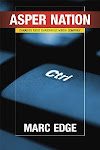We now have a clear pro-Harper tilt from the two big private TV nets, CTV and Global. . . . There's the National Post, the CanWest papers under the stern Asper thumb, the Suns and Maclean's, the sole national newsmag. Outside the tent are just the Toronto Star, The Globe and Mail, which more or less defines the centre and has always been a conservative business-oriented paper, and the CBC.Even the public broadcaster, noted Salutin, is hardly as small-l liberal as in the past, given the political and media climate that might see it privatized just as soon as Harper can pull a majority in Parliament. “Public broadcasters tend to run scared under right-wing governments,” noted Salutin. “The BBC did in the Thatcher years and the CBC did in the Mulroney era.” Still, as he pointed out, it was “striking that majority voter opinion has remained statistically firm,” with the social democratic vote remaining at 60-65 percent, albeit split between four parties.
More worrying to me is the rightward shift in coverage on the Left Coast, from where I hail. One of the few non-conservative print publications in Vancouver, the Georgia Straight weekly entertainment giveaway tabloid, noted the trend and promised to do what it could to oppose it. “Vancouver is not a conservative city,” moaned news editor Charlie Smith. “And Vancouver doesn’t need another conservative paper telling us we should vote for a guy who relied on a plagiarized speech in 2003 to explain why Canadian kids should be sent to their deaths in Iraq.” Smith professed astonishment at the Vancouver Sun’s coverage of that embarrasing mid-campaign disclosure, which was buried on the inside pages. Coverage of the environment, traditionally a hot topic in Beautiful British Columbia, had received similar short shrift, from what Smith could see.
Climate change is perhaps Harper’s weakest issue. By not hammering away at this, the Canwest media and its columnists are helping to ensure that the environment flies somewhat under the radar during this campaign. No wonder the pollsters are saying it’s not very high on the list of public concerns at the moment.Smith nicely encapsulated an example of agenda-setting theory, which posits that issues not covered prominently in the news media are not perceived as important by citizens, and vice-versa. Pioneered by media theorist Max McCombs of the University of Texas, with whom I spent some time this summer at a conference in New Zealand, it is a theory that truly demonstrates media power over the public mind. Its wonderfully succint bottom line is that while the media cannot tell us what to think, they can greatly influence what we think ABOUT. The phenomenon has been deomonstrated in replications that have numbered in the hundreds worldwide in the four decades since McCombs and Donald Shaw conducted their first agenda-setting study in North Carolina. (The results of which, Max told the Australia New Zealand Communication Association conference, were first rejected as a conference paper before being published in Public Opinion Quarterly.)
This is where the perils of concentrated media ownership become apparent. A few large media owners, as in Canada where they now own both newspapers and television, are both more powerful in molding public opinion and more susceptible to political influence. If there is anything I have noticed down here in the Excited States, it is that coverage of this presidential campaign has been much more diverse that four years ago, when I was teaching at another school in Texas. The emergence of MSNBC as a liberal alternative, led by the riotous rants of Countdown’s Keith Olbermann, has re-stretched a media spectrum that once crowded the right side of the dial to emulate the jingoist popularity of Rupert Murdoch’s Fox News – or “Fixed Noise," as Olbermann now calls it. As a result, Americans will tomorrow elect a president who is for a change more liberal that Canada’s leader. It is a testament to the power of media diversity. Will the pendulum swing back to the left north of the border? Not until the Canadian media becomes more (wait for it) Fair and Balanced. We could be waiting for awhile.

